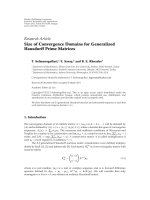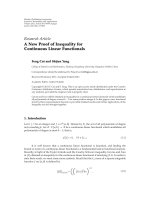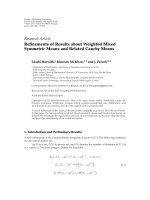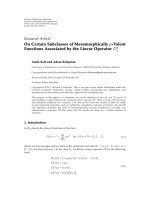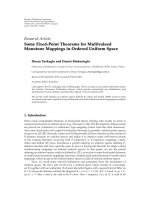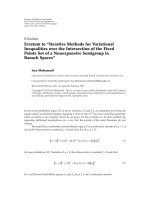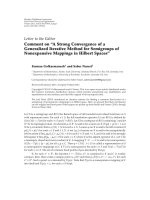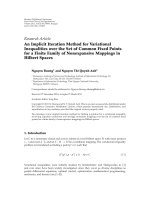Hindawi Publishing Corporation Advances in Difference Equations Volume 2011, Article ID 394584, 9 pptx
Bạn đang xem bản rút gọn của tài liệu. Xem và tải ngay bản đầy đủ của tài liệu tại đây (487.99 KB, 9 trang )
Hindawi Publishing Corporation
Advances in Difference Equations
Volume 2011, Article ID 394584, 9 pages
doi:10.1155/2011/394584
Research Article
Some Results on n-Times Integr ated C-Regularized
Semigroups
Fang Li, Huiwen Wang, and Zihai Qu
School of Mathematics, Yunnan Normal University, Kunming 650092, China
Correspondence should be addressed to Huiwen Wang,
Received 21 October 2010; Accepted 13 December 2010
Academic Editor: Toka Diagana
Copyright q 2011 Fang Li et al. This is an open access article distributed under the Cr eative
Commons Attribution License, which permits unrestricted use, distribution, and reproduction in
any medium, provided the original work is properly cited.
We present a generation theorem of n-times integrated C-regularized semigroups and clarify the
relation between differentiable n 1-times integrated C-regularized semigroups and singular
n-times integrated C-regularized semigroups.
1. Introduction and Preliminaries
In 1987, Arendt 1 studied the n- times integrated semigroups, which are more general than
C
0
semigroups there exist many operators that generate n- times integrated semigroups but
not C
0
semigroups.
In recent years, the n-times integrated C-regularized semigroups have received much
attention because they can be used to deal with ill-posed abstract Cauchy problems and
characterize the “weak” well-posedness of many important differential equations cf., e.g.,
2–18.
Stimulated by the works in 2, 5–7, 9, 12–18, in this paper, we present a generation
theorem of the n-times integrated C-regularized semigroups for the case that the domain
of generator and the range of regularizing operator C are not necessarily dense, and prove
that the subgenerator of an exponentially bounded, differentiable n 1-times integrated C-
regularized semigroup is also a subgenerator of a singular n-times integrated C-regularized
semigroup.
Throughout this paper, X is a Banach space; X
∗
denotes the dual space of X; LX, X
denotes the space of all linear and bounded operators from X to X, it will be abbreviated
to LX; LX
∗
denotes the dual space of LX.ByC
1
0, ∞,X we denote the space of all
continuously differentiable X-valued functions on 0, ∞. C0, ∞,X is the space of all
continuous X-valued functions on 0, ∞.
2AdvancesinDifference Equations
All operators are linear. For a closed linear operator A,wewriteDA, RA, ρA for
the domain, the range, the resolvent set of A in a Banach space X, respectively.
We denote by A
0
A|
DA
the part of A in DA,thatis,
D
A
0
:
x ∈ D
A
; Ax ∈
D
A
,A
0
x Ax, for x ∈ D
A
0
. 1.1
The C-resolvent set of A is defined as:
ρ
C
A
λ ≥ 0;
λ − A
is injective,R
C
⊂ R
λ − A
and
λ − A
−1
C ∈ L
X
. 1.2
We abbreviate n-times integra ted C-regularized semigroup to n-times integrated
C-semigroup.
Definition 1.1. Let n be a nonnegative integer. Then A is the subgenerator of an exponentially
bounded n-times integrated C-semigroup {St}
t≥0
if ω, ∞ ⊂ ρ
C
A for some ω ≥ 0and
there exists a strongly continuous family S· : 0, ∞ → LX with St≤Me
ωt
for some
M>0suchthat
λ − A
−1
Cx λ
n
∞
0
e
−λt
S
t
xdt
λ>ω,x∈ X
.
1.3
In this case, {St}
t≥0
is called the exponentially bounded n-times integra ted
C-semigroup generated by
A : C
−1
AC.
If C I resp., n 0,thenA is called a generator of an exponentially bounded n-times
integrated semigroup resp., C-semigroup.
We recall some properties of n-times integrated C-semigroup.
Lemma 1.2 see 10, Lemma 3.2. Assume that A is a subgenerator of an n-times integrated
C-semigroup {St}
t≥0
.Then
i StC CStt ≥ 0,
ii Stx ∈ DA,andAStx StAx t ≥ 0,x∈ DA,
iii Stx t
n
/n!Cx A
t
0
Ssxdst ≥ 0,x∈ X.
In particular, S00.
Definition 1.3 . Let ω ≥ 0. If ω, ∞ ⊂ ρ
C
A and there exists {St}
t≥0
⊂ LX such that
i S00andS· : 0, ∞ → LX is strongly continuous,
ii for λ>ω,
∞
0
e
−λt
Stdt < ∞,
iiiλ − A
−1
Cx λ
n
∞
0
e
−λt
Stxdt, λ>ω, x ∈ X,
then we say that {St}
t≥0
is a singular n-times integrated C-semigroup with subgenerator A.
Remark 1.4. Clearly, an exponentially bounded n-times integrated C-semigroup is a singular
n-times integrated C-semigroup. But the converse is not true.
Advances in Difference Equations 3
2. The Main Results
Theorem 2.1. Let M>0, ω ≥ 0 be constants, and let A be a closed operator satisfying ω, ∞ ⊂
ρ
C
A. Assume that ϕt is the nonnegative measurable function on 0, ∞. A necessary and sufficient
condition for A is the subgenerator of an n 1-times integrated C-semigroup {St}
t≥0
satisfying
A1 lim sup
λ →∞
λ
n2
∞
0
e
−λt
Stdt≤M,
A2 St − Ss≤
s
t
ϕue
ωu
du, 0 ≤ t ≤ s,isthatforλ>ω,
i lim sup
λ →∞
λλ − A
−1
C≤M,
ii λ − A
−1
C/λ
n
m
≤
∞
0
e
−λ−ωt
t
m
ϕtdt, m 1, 2,
Proof. Sufficiency.Letψte
ωt
ϕt.Set
f
λ
∞
0
e
−λt
ψ
t
dt
∞
0
e
−λ−ωt
ϕ
t
dt, λ > ω. 2.1
For x
∗
∈ X
∗
,wehave
λ − A
−1
C
λ
n
x
m
,x
∗
≤
x
·
x
∗
∞
0
e
−λt
t
m
ϕ
t
dt
≤
x
·
x
∗
· f
λ
m
,m 1 , 2,
2.2
Using this fact together with Widder’s classical theorem, it is not difficult to see that
the existence of a measurable function h·,x,x
∗
with |ht, x, x
∗
|≤x
∗
xψt,a.e.,t ≥ 0
such that
λ − A
−1
C
λ
n
x, x
∗
∞
0
e
−λt
h
t, x, x
∗
dt, λ > ω. 2.3
Let Ht, x, x
∗
t
0
hs, x, x
∗
ds, t ≥ 0, x
∗
∈ X
∗
. In view of the convolution theorem for
Laplace transforms and from 2.3,wehave
λ − A
−1
C
λ
n
x, x
∗
λ
∞
0
e
−λt
H
t, x, x
∗
dt, λ > ω, x
∗
∈ X
∗
. 2.4
Using the uniqueness of Laplace transforms and the linearity of h·,x,x
∗
for each
x
∗
∈ X
∗
, x ∈ X,wecanseethatforeacht ≥ 0, Ht, x, x
∗
is linear and
|
H
t h, x, x
∗
− H
t, x, x
∗
|
≤
th
t
|
h
s, x, x
∗
|
ds ≤
x
·
x
∗
th
t
ψ
s
ds. 2.5
4AdvancesinDifference Equations
Hence for all t ≥ 0, there exists St ∈ LX
∗∗
such that
H
t, x, x
∗
S
t
x, x
∗
,x∈ X, x
∗
∈ X
∗
, 2.6
S
t h
− S
t
≤
th
t
ψ
s
ds, t ≥ 0,h≥ 0, 2.7
λ − A
−1
C
λ
n
λ
∞
0
e
−λt
S
t
dt.
2.8
Denote by q : Lx
∗∗
→ Lx
∗∗
/LX the quotient mapping. Since λ − A
−1
C ∈ LX,
we deduce
0 q
λ − A
−1
C
λ
n
λ
∞
0
e
−λt
q
S
t
dt. 2.9
It follows from the uniqueness theorem for Laplace transforms that qSt 0, that is, St ∈
LX.
Combining 2.7 and 2.8 yields that St : 0, ∞ → LX is strongly continuous and
∞
0
e
−λt
S
t
dt ≤
∞
0
e
−λt
t
0
ψ
s
ds dt
1
λ
∞
0
e
−λt
ψ
t
dt < ∞. 2.10
Now, we conclude that {St}
t≥0
is an n 1-times integrated C-semigroup satisfying
A2. Assertion A1 is immediate, by 2.8 and i.
Necessity. Let ψte
ωt
ϕt.Since{St}
t≥0
is an n 1 - times integrated C-semigroup on X,
we have
λ − A
−1
C λ
n1
∞
0
e
−λt
S
t
dt
2.11
for λ>ω.NotingthatSt h − St≤
th
t
ψs ds h ≥ 0 and S00, we find
S
t
≤
t
0
ψ
s
ds.
2.12
Then for any y
∗
∈ LX
∗
and λ>ω,weobtain
λ − A
−1
C
λ
n
,y
∗
λ
∞
0
e
−λt
S
t
dt, y
∗
≤ λ
∞
0
e
−λt
S
t
·
y
∗
dt ≤
y
∗
∞
0
e
−λt
ψ
t
dt.
2.13
Advances in Difference Equations 5
Therefore, there exists a measurable function ηt on 0, ∞ with |ηt|≤ψta.e.
such that
λ − A
−1
C
λ
n
∞
0
e
−λt
η
t
dt. 2.14
Furthermore, by calculation, we have
λ − A
−1
C
λ
n
m
≤
∞
0
e
−λt
t
m
ψ
t
dt
∞
0
e
−λ−ωt
t
m
ϕ
t
dt, m 1, 2, 2.15
Assertion i is an immediate consequence of 2.11 and A1.
Remark 2.2. If n 0andC I,then{St}
t≥0
is an integrated semigroup in the sense of
Bobrowski 2.
Theorem 2.3. Let M>0, ω ≥ 0 be constants, and let A be a closed operator satisfying ω, ∞ ⊂
ρA. Assume that A is a subgenerator of an n 1-times integrated C-semigroup {St}
t≥0
and
satisfies (ii) of Theorem 2.1 and lim sup
λ →∞
λλ − A
−1
≤M.IfA
0
A|
DA
is a subgenerator of
an n-times integrated C-semigroup {S
0
t}
t≥0
on DA,thenforμ ∈ ρA, x ∈ X,
S
t
x
μ − A
0
t
0
S
0
s
μ − A
−1
xds,
2.16
S
t
x lim
μ →∞
μ
t
0
S
0
s
μ − A
−1
xds.
2.17
Proof. For μ ∈ ρA, x ∈ X,set{
St}
t≥0
as follows:
S
t
x μ
t
0
S
0
s
μ − A
−1
xds− S
0
t
μ − A
−1
x
t
n
n!
μ − A
−1
Cx.
2.18
Since S
0
t is strongly continuous on DA,
St is strongly continuous on X.
Fixing λ>ω,wehave
λ
n1
∞
0
e
−λt
S
t
xdt λ
n
μ − λ
∞
0
e
−λt
S
0
t
μ − A
−1
xdt
μ − A
−1
Cx
μ − λ
λ − A
−1
C
μ − A
−1
x
μ − A
−1
Cx
λ − A
−1
Cx.
2.19
It follows from the uniqueness of Laplace transforms that Stx
Stx, x ∈ X.Soweget
2.16. By the hypothesis lim sup
λ →∞
λλ − A
−1
≤M,wesee
6AdvancesinDifference Equations
S
t
x lim
μ →∞
μ
t
0
S
0
s
μ − A
−1
xds− S
0
t
μ − A
−1
x
t
n
n!
μ − A
−1
Cx
lim
μ →∞
μ
t
0
S
0
s
μ − A
−1
Cx ds,
2.20
and the proof is completed.
Now, we study the relation between differentiable n 1-times integrated C-
semigroups and singular n-times integrated C-semigroups.
Theorem 2.4. Let ω ≥ 0,andletA be a closed operator satisfying ω, ∞ ⊂ ρ
C
A. Assume that
ϕt is the nonnegative measurable function on 0, ∞. The following two assertions are equivalent:
1 A is the subgenerator of a singular n-times integrated C-semigroup {Ut}
t≥0
satisfying
Ut≤ϕte
ωt
.
2 A is the subgenerator of an exponentially bounded n 1-times integrated C-semigroup
{St}
t≥0
satisfying
S
t
− S
s
≤
s
t
ϕ
τ
e
ωτ
dτ, 0 ≤ t ≤ s,
S
t
x ∈ C
1
0, ∞
,X
, for x ∈ X.
2.21
Proof. 1⇒2:weset
S
t
x :
t
0
U
s
xds, t≥ 0.
2.22
Since Utx is locally integrable on 0, ∞,Stx is well-defined for any x ∈ X.Itiseasyto
check that Stx belongs to C
1
0, ∞,X.
For every λ>ω,since
S
t
x
t
0
e
−λs
e
λs
U
s
xds
≤ e
λt
t
0
e
−λs
U
s
x
ds ≤ Me
λt
x
, 2.23
we deduce that St is exponentially bounded.
Moreover, for λ>ω,wehave
λ − A
−1
Cx λ
n
∞
0
e
−λt
U
t
xdt λ
n1
∞
0
e
−λt
S
t
xdt,
S
t
− S
s
s
t
U
τ
dτ
≤
s
t
ϕ
τ
e
ωτ
dτ, 0 ≤ t ≤ s.
2.24
Thus {St}
t≥0
is the desired semigroup in 2.
Advances in Difference Equations 7
2⇒1:foranyx ∈ X,weset
U
t
x :
d
dt
S
t
x, for t>0,
U
0
x : 0, for t 0.
2.25
Then Utx ∈ C0 , ∞,X and U00.
Noting that
S
t h
− S
t
≤
th
t
ϕ
s
e
ωs
ds, 2.26
we find
S
t h
− S
t
h
≤
1
h
th
t
ϕ
s
e
ωs
ds. 2.27
Since Stx is continuously differentiable for t>0, we get
U
t
≤ ϕ
t
e
ωt
a.e.
. 2.28
Moreover, for λ>ω,wehave
∞
0
e
−λt
U
t
dt ≤
∞
0
e
−λ−ωt
ϕ
t
dt < ∞,
λ − A
−1
Cx λ
n1
∞
0
e
−λt
S
t
xdt λ
n
∞
0
e
−λt
U
t
xdt.
2.29
Thus, {Ut}
t≥0
is a singular n-times integrated C-semigroup with subgenerator A.
Theorem 2.5. Let M>0, ω ≥ 0 be constants, and let A be a closed operator satisfying ω, ∞ ⊂
ρA.Letϕt be the function in Theorem 2.4.IfA is the subgenerator of a singular n-times integrated
C-semigroup {Ut}
t≥0
, satisfying Ut≤ϕte
ωt
, and satisfies
lim sup
λ →∞
λ
λ − A
−1
≤ M
λ>ω
,
2.30
then
1 for λ>ω, x ∈ X, Utx λ − A
0
S
0
tλ − A
−1
x,
2 for x ∈
DA, lim
t → 0
Utx 0,
3 for λ>ω, x ∈ X, Utx lim
λ →∞
λS
0
tλ − A
−1
x,
4 for λ>ω, x ∈
DA if and only if lim
λ →∞
λ
n1
∞
0
e
−λt
Utxdt Cx,
where A
0
and S
0
t are the symbols mentioned in Theorem 2.3.
8AdvancesinDifference Equations
Proof. It follows from Theorems 2.3 and 2.4 that A subgenerates an n 1-times integrated
C-semigroup {St}
t≥0
, which is continuously differentiable for t>0 and satisfies 2.16 and
2.17.
Differentiating 2.16 with respect to t,weobtain
U
t
x
d
dt
S
t
x
λ − A
0
S
0
t
λ − A
−1
x, x ∈ X, λ > ω.
2.31
This completes the proof of 1.
To show 2,forx ∈
DA,wehave
U
t
x
λ − A
0
S
0
t
λ − A
−1
x S
0
t
x.
2.32
Letting t → 0
,weget
lim
t → 0
U
t
x 0,x∈ DA.
2.33
To show 3,forx ∈ X,sinceStx ∈ C
1
0, ∞,X, it follows from 2.17 that
lim
λ →∞
λS
0
tλ − A
−1
x is continuous for t>0, thus, we have
U
t
x
d
dt
S
t
x lim
λ →∞
λS
0
t
λ − A
−1
x, t > 0.
2.34
Obviously, the equality above is true for t 0.
Noting that
lim sup
λ →∞
λ
λ − A
−1
≤ M
λ>ω
,
2.35
we can deduce that x ∈
DA implies lim
λ →∞
λλ − A
−1
Cx Cx,andfrom
λ − A
−1
Cx λ
n
∞
0
e
−λt
U
t
xdt,
2.36
assertion 4 isimmediateifwenotethatlim
λ →∞
λλ − A
−1
Cx Cx implies x ∈ DA.
Acknowledgments
The authors are grateful to the referees for their valuable suggestions. This work is supported
by the NSF of Yunnan Province 2009ZC054M.
References
1 W. Arendt, “Vector-valued Laplace transforms and Cauchy problems,” Israel Journal of Mathematics,
vol. 59, no. 3, pp. 327–352, 1987.
Advances in Difference Equations 9
2 A. Bobrowski, “On the generation of non-continuous semigroups,” Semigroup Forum,vol.54,no.2,
pp. 237–252, 1997.
3 Y C. Li and S Y. Shaw, “On local α-times integrated C-semigroups,” Abstract and Applied Analysis,
vol. 2007, Article ID 34890, 18 pages, 2007.
4 Y C. Li and S Y. Shaw, “On characterization and perturbation of local C-semigroups,” Proceedings of
the American Mathematical Society, vol. 135, no. 4, pp. 1097–1106, 2007.
5 J. Liang a nd T J Xiao, “Integrated semigroups and higher order abstract equations,” Journal of
Mathematical Analysis and Applications, vol. 222, no. 1, pp. 110–125, 1998.
6 J. Liang and T J Xiao, “Wellposedness results for certain classes of higher order abstract Cauchy
problems connected with integrated semigroups,” Semigroup Forum, vol. 56, no. 1, pp. 84–103, 1998.
7 J. Liang and T J Xiao, “Norm continuity for t>0 of linear operator families,” Chinese Science Bulletin,
vol. 43, no. 9, pp. 719–723, 1998.
8 K. Nagaoka, “Generation of the integrated semigroups by superelliptic differential operators,” Journal
of Mathematical Analysis and Applications, vol. 341, no. 2, pp. 1143–1154, 2008.
9 N. Tanaka, “Locally Lipschitz continuous integrated semigroups,” Studia Mathematica, vol. 167, no. 1,
pp. 1–16, 2005.
10 H. R. Thieme, ““Integrated semigroups” and integrated solutions to abstract Cauchy problems,”
Journal of Mathematical Analysis and Applications, vol. 152, no. 2, pp. 416–447, 1990.
11 H. R. Thieme, “Differentiability of convolutions, integrated semigroups of bounded semi-variation,
and the inhomogeneous Cauchy problem,” Journal of Evolution Equations, vol. 8, no. 2, pp. 283–305,
2008.
12 T J Xiao and J. Liang, “Integrated semigroups, cosine families and higher order abstract Cauchy
problems,” in Functional Analysis in China, vol. 356 of Mathematics and Its Applications, pp. 351–365,
Kluwer Academic Publishers, Dordrecht, The Netherlands, 1996.
13 T J Xiao and J. Liang, “W idder-Arendt theorem and integrated semigroups in locally convex space,”
Science in China. Series A, vol. 39, no. 11, pp. 1121–1130, 1996.
14
T J Xiao and J. Liang, “Laplace transforms and integrated, regularized semigroups in locally convex
spaces,” Journal of Functional Analysis, vol. 148, no. 2, pp. 448–479, 1997.
15 T J. Xiao and J. Liang, The Cauchy Problem for Higher-Order Abstract Differential Equations, vol. 1701 of
Lecture Notes in Mathematics, Springer, Berlin, Germany, 1998.
16 T J. Xiao and J. Liang, “Approximations of Laplace transforms and integrated semigroups,” Journal
of Functional Analysis, vol. 172, no. 1, pp. 202–220, 2000.
17 T J. Xiao and J. Liang, “Higher order abstract Cauchy problems: their existence and uniqueness
families,” Journal of the London Mathematical Society, vol. 67, no. 1, pp. 149–164, 2003.
18 T J. Xiao and J. Liang, “Second order differential operators with Feller-Wentzell type boundary
conditions,” Journal of Functional Analysis, vol. 254, no. 6, pp. 1467–1486, 2008.
